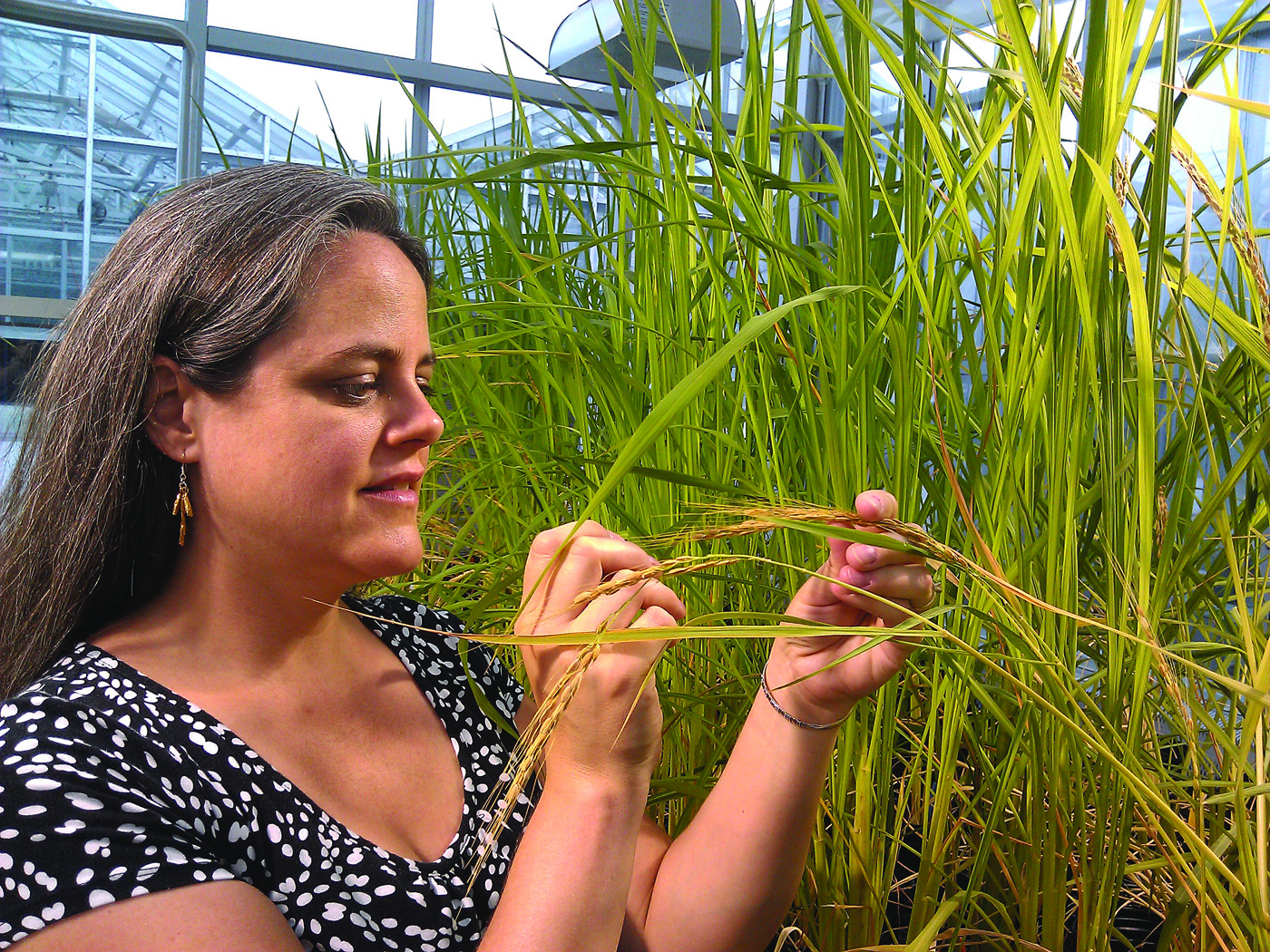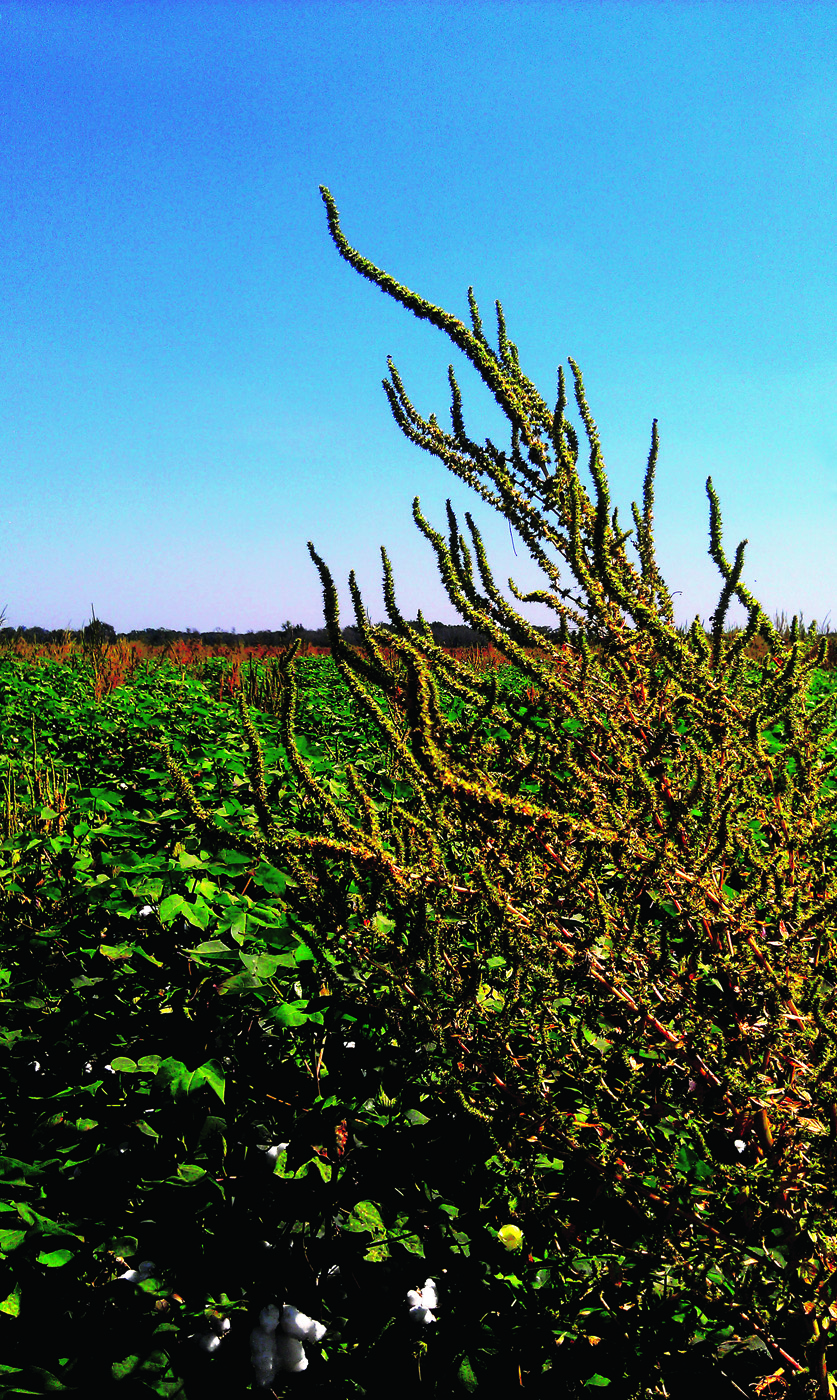A pestilence of pigweed
by Peter Kent
Spreading hundreds of thousands of seeds, one plant can doom a crop. Where is its weakness?
 Amy Lawton-Rauh studies the escape artists that have broken away from domestication, such as weedy rice, and also plants that evolve to capture an agricultural ecosystem, including Palmer amaranth. Photo courtesy of Brad Rauh.
Amy Lawton-Rauh studies the escape artists that have broken away from domestication, such as weedy rice, and also plants that evolve to capture an agricultural ecosystem, including Palmer amaranth. Photo courtesy of Brad Rauh.
A plant that can take the heat
Mapping the pathways with math
Molecular mother lode
If Palmer amaranth were a smell, it would be skunk odor. Unlovingingly called pigweed, the plant is pervasive and enduring, and a little of it goes a long way. One plant can ruin a field if untreated.
“I know when I see it, I have got to kill it,” says Matt Fischer, who oversees crops on Clemson’s Simpson Experiment Station, a cattle and crop research farm.
If he doesn’t, where there’s one pigweed today, there may be half a million by next growing season. It’s a weed population bomb, and defusing it is getting harder and harder.
Amy Lawton-Rauh studies plant species and populations, looking at speciation mechanisms, which is how evolutionary forces give rise to separate populations and new species. She specializes in the “capture and escape” genetic processes of plants grown as crops. Her work can mean the difference between profit or loss for farmers and between food or famine in the future for much of the human population.
“Basically we’re studying plants that are weedy wild relatives of crops—the escape artists that have escaped domestication—and the plants that evolve to adapt to crop conditions and get captured in the agricultural ecosystem by competing with crops for resources, exploding in population size, and rapidly becoming huge problems,” Lawton-Rauh says.
“My work as a population geneticist is to explain variation in traits and genomes,” she adds. “What we do is figure out how different gene variations—they’re called alleles—occur in a population and how these variations move around populations and species through gene flow.”
A new species can occur because of geographical isolation and new mutations, interbreeding, or environmental pressure. Whatever the cause, the populations establish themselves and persist. For an adaptation to endure, it must be passed on to new generations. Lawton-Rauh wants to know how populations originate and adapt, and how adapted alleles spread among populations and species. She also seeks how to manage this spread and prevent disasters.
“We strive to contribute to and translate the latest research in population and evolutionary genetics into problem-solving approaches,” she says. “There are amazing examples of how humans have created strong selection pressures, leading to highly adapted populations. Why not use these examples as tools to aid research-informed decisions?”
Roundup and Roundup Ready crops were meant to be a boon to farmers and help a hungry world by killing weeds. It hasn’t worked out as expected.
When Monsanto discovered glyphosate in the 1970s, it hit a home run. The product became the most popular weed killer in farm fields and home gardens. Then Monsanto hit a grand slam. In the 1990s, the company launched the first Roundup Ready crop, a soybean genetically altered to tolerate glyphosate. Roundup Ready plants were unharmed while the weeds were killed, and glyphosate was relatively safe to handle. It also decomposed rapidly, minimized the need for tilling, and reduced the need for other herbicides. Eventually, cotton and corn joined soybean as Roundup Ready crops. But then nature took a turn.
“Nature bats last,” says environmentalist Bill McKibben about the relentless power of adaptation.
The weeds have taken the lead.
Around 2004 some weeds became Roundup resistant. Horseweed, water hemp, giant ragweed, and Palmer amaranth have spread near and far, from South Carolina throughout the South and Midwest to Brazil, China, and Australia. Referred to as “superweeds” by some, they capture fields, crowd out crops, and run costs up to hand weed, plow under, and spray with other herbicides. The superweeds are major threats to production agriculture, environmental safety, and food security.
Pigweed quickly caught the attention of Lawton-Rauh, who studies evolutionary genetics.
“It is an example of a capture plant because it used to be minimally distributed in the southeastern United States and was even used as a food source by foragers and some Native American tribes,” she says. “Now it is a highly adapted, more broadly distributed, aggressive agricultural weed.”
Pigweed can grow three inches a day, reaching seven feet tall, with a deep tap root and stout stalk. Pigweed’s most impressive feat is its reproduction.
“One plant can produce as many as five hundred thousand seeds,” Lawton-Rauh says. “You can imagine what happens when a field has five plants—two-and-a-half million seeds. This is like two-and-a-half million genetic experiments. The seeds are very small and easily transported. When we work with them in the lab, we put up signs not to enter.”
Lawton-Rauh works with researchers and producers in Arkansas, along with colleagues in North Carolina, Georgia, and Europe. Cotton growers have been devastated by pigweed, and Cotton Incorporated has been a primary funder of the research. In June, Southeast Farm Press wrote about a Weed Science journal report of Palmer amaranth’s impact on Arkansas cotton fields. In the study, researchers determined what would happen if 20,000 seeds—2 percent of the seed potential of a single plant—were released on a square mile test area. The headline was: “One weed leads to complete crop failure.”
Cotton isn’t pigweed’s only conquest. More than forty crops, including soybean, corn, and potatoes, fall prey to pigweed as it invades fields and monopolizes water, nutrients, and light. Yield losses can run nearly to half from pigweed infestation.
What the researchers want to know is the origin of adaptive gene variations in Palmer amaranth and how these variations spread across populations through gene flow. It can’t be just because of all those seeds. There can be too much distance between outbreaks, even though seeds can easily hitch a ride on floodwater, tornado winds, or muddy boots.
“Our work indicates that glyphosate resistance also spreads by independent mutation,” Lawton-Rauh says. “That many seeds mean that there are millions of opportunities for new mutations, adaptations, and genetic combinations leading to possible survival across many conditions.”
Glyphosate works by binding within a protein known as EPSPS, which is coded by a part of a plant’s DNA, preventing the production of essential proteins. Normally, there’s only one copy of the gene in a cell, which makes it easy for glyphosate to block the protein and kill the plant. Pigweed has adapted by making hundreds of copies of the gene and scattering these throughout the plant’s genome so that massive amounts of the EPSPS protein can be produced. Glyphosate can’t lock into every EPSPS protein produced. Pigweed flourishes.
“We weren’t the ones who found the gene copy number correlation with glyphosate resistance,” Lawton-Rauh says. “We were the ones who found out that resistance can arise independently and how the number correlates with origins and adaptation in populations—how copy numbers and genetic variations arise and move around pigweed populations.”
The correlation is not one-to-one, but above a general threshold number of copies there is some glyphosate resistance.
To test her hypotheses, Lawton-Rauh collects pigweed samples. They arrive in brown paper bags holding the snipped seed heads sent in by research scientists working with Clemson extension agents and growers who have been trained in how to collect samples. The researchers use the seeds to grow plants and then analyze the leaves.
“Our research will help us understand basic evolutionary genomics processes, how herbicide resistance develops, and how to manage crop production to reduce the pressures put on weeds to adapt,” Lawton-Rauh says.
Where Palmer amaranth increased gene variation by adding gene copies to adapt, another plant escaped its domesticated genes. “Our escape artists are rice populations where crop rice interacts with its wild relatives and weedy populations. These interactions can lead to aggressive weedy rice or sometimes crop rice plants that go wild and become weedy,” Lawton-Rauh says. “Weedy rice is an excellent model for understanding how weediness happens in production agriculture and for the stability of the domestication process.”
Rice cultivars feed more than half of the world’s seven billion people, and by 2050 production will need to increase by roughly 40 percent to meet the demands of some nine billion people. Weedy rice will yield empty bellies.
Rice breeders selected traits that would enhance yield, satisfy culinary tastes, and reduce production effort. They developed varieties that were compact and had heavy seed heads that matured and dropped seed predictably. Weedy rice develops at different times than its crop cousins, escaping harvest. It also produces fewer rice grains of poorer quality and is difficult to control. Changes in the way growers plant rice, using seed drilled into the soil instead of farmhands planting seedlings, mean fewer watchful eyes to identify weedy rice and remove it.
“Weedy rice has a long seed dormancy, which allows it to come up during the next growing season,” Lawton-Rauh says. “Crop rice is nondormant to prevent its growing. We want nondormant seed so it won’t compete with another crop in rotation, such as soybean.”
Finding the gene variations in the weedy rice genome that trigger the emergence of undesirable traits like seed dormancy contributes towards basic scientific knowledge. It’s also one step toward controlling weedy close relatives of crops.
Another step will be to compare the weedy rice population genetics around the world to determine how it spreads in order to develop management strategies.
One solution being tried in the United States is herbicide-tolerant rice cultivars, which would let growers spray to kill the weeds but not harm the rice crop. Already there is concern about weedy rice becoming herbicide resistant.
Nature steps up to the plate for another at bat.
 Palmer amaranth, also known as pigweed, grows fast, resists herbicides, and spreads like wildfire. Photo by Amy Lawton-Rauh.
Palmer amaranth, also known as pigweed, grows fast, resists herbicides, and spreads like wildfire. Photo by Amy Lawton-Rauh.
Amy Lawton-Rauh is the principal investigator of the Lawton-Rauh Laboratory for molecular evolution and population genetics, and an associate professor in the Department of Genetics and Biochemistry, College of Agriculture, Forestry, and Life Sciences. Peter Kent is a news editor and writer in Clemson’s Public Affairs Activities.


